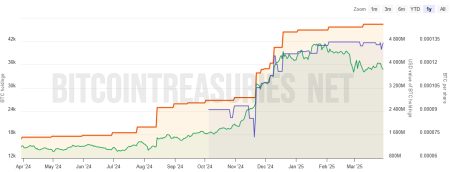Last updated:
 Why Trust Cryptonews
Why Trust Cryptonews

The once-booming interest in meme coins is waning, leading to renewed enthusiasm for more established assets such as Bitcoin (BTC) and Ether (ETH), as well as other Layer-1 (L1) coins.
Crypto analyst Michaël van de Poppe suggested in his Feb. 17 X post that fatigue over meme coin speculation and an increased focus on utility-driven assets are driving the change.
He noted that the “meme coin fiesta has been an inner-circle money printer for a small group of people,” comparing the trend to decentralized finance (DeFi) mania in 2020. The analyst believes the market is now returning to reality, allowing “real coins to shine.”
$ETH season starts over $SOL season.
The memecoin fiesta has been an inner-circle money printer for a small group of people and everybody knows about it now. $SOL memes = #DeFi of 2020
Now it’s back to reality and the real coins to shine.
— Michaël van de Poppe (@CryptoMichNL) February 17, 2025
A Healthier Market Cycle Ahead?
Crypto analytics firm Santiment, which analyzes social sentiment and trading activity, echoed this sentiment, stating in its Feb. 11 X post that discussion of the top Layer-1 blockchains currently dominates 44% of social media conversations, while meme coins only capture 4%.
According to Santiment, this focus on Layer-1s is “a sign of a more stable and sustainable market environment,” indicating maturity in the crypto space:
“Historically, meme coin frenzies precede market corrections, as speculative excesses often lead to sharp reversals when hype fades. When traders pivot back to assets with strong utility and established market positions, it suggests a healthier market cycle. This shift encourages a more balanced ecosystem, reducing the risk of unsustainable price surges and crashes fueled purely by speculative mania.”
Santiment’s data also shows that discussions around Binance Chain (BNB) are gaining traction, largely due to its recent bullish performance and the fact that its market capitalization recently surpassed Solana (SOL), making it the fifth-largest cryptocurrency.
Despite their past popularity, meme coins such as Dogecoin (DOGE), Shiba Inu (SHIB), and Pepe (PEPE) are experiencing a decline in social media attention, according to Santiment, likely due to the volatility and unpredictability associated with these assets.
Historically, meme coin cycles have been driven by short-term speculation rather than long-term investment strategies. Santiment noted that such cycles typically precede market corrections, as traders chase quick gains before sentiment ultimately shifts back to more stable assets.
However, some meme coins are still making waves. One example is the Broccoli (BROCCOLI) token, which has gained attention due to its association with Binance founder Changpeng Zhao’s dog.
🗣️ The top trending topics that are circulating across crypto social media Thursday are:
🥦 Broccoli is trending due to its association with a meme coin linked to the dog owned by @cz_binance. The Broccoli token has gained attention on social media, particularly X, as users… pic.twitter.com/8GY3p5v6dM
— Santiment (@santimentfeed) February 13, 2025
Social media users are discussing the token’s market cap and trading volume, but Santiment cautions that its rise may be temporary, as speculative interest in meme coins has been known to fade quickly.




